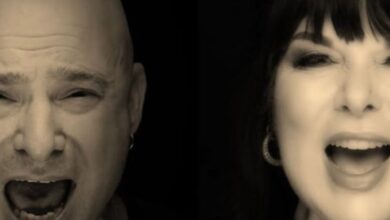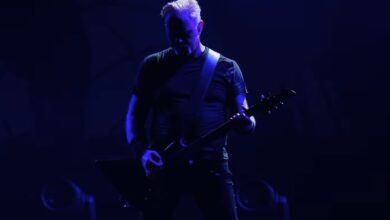The Viking Rendition That Rivals Disturbed: A Powerful New Take on “The Sound of Silence”
Ever wondered what it would feel like to watch lightning strike twice in the same song? That’s precisely the sensation flooding social-media feeds since bass powerhouse Peyton Parrish dropped his brooding new cover of “The Sound of Silence.” Imagine Disturbed’s billion-view juggernaut colliding head-on with vintage hard-rock grit: the result is a dark, slow-burning storm that has fans hitting replay well past midnight.
Long before Parrish pressed record, the track’s modern legacy already loomed large. Disturbed transformed Simon & Garfunkel’s folk whisper into a cinematic thunderclap back in 2015, generating more than a billion YouTube views and snagging Paul Simon’s personal approval. That towering benchmark might intimidate most artists, yet Parrish saw it as a summit worth scaling, bringing his own low-end swagger to the climb.
For the uninitiated, Peyton Parrish is hardly a newcomer. The Los Angeles–born singer cut his teeth on Viking-metal renditions of Disney anthems and Nordic battle hymns, cultivating a massive TikTok following drawn to the furnace rumble of his bass voice. Fans who discovered him through viral takes on “Valhalla Calling” already knew he could shake rafters; they just hadn’t heard him aim that power at a modern rock classic—until now.
Parrish teased the project with a 15-second TikTok posted from his home studio: dim lights, candle glow, and a single lyric—“Hello darkness, my old friend”—delivered so low it seemed to rattle the phone’s speaker. Within hours the clip logged hundreds of thousands of loops, and commenters begged for the full track, comparing his tone to a cross between a cathedral organ and a diesel engine idling at midnight.
When the complete version dropped on July 15, 2022, listeners immediately noticed the production’s throwback edge. Disturbed’s rendition builds on sepulchral piano and orchestral swells; Parrish leans into classic-rock instrumentation, opening with fingerpicked electric guitar run through vintage tube amps before layering in tom-heavy drums that feel lifted from a late-’70s power ballad. The contrast is deliberate, paying homage to the song’s folk roots while grounding it in arena-ready crunch.
Vocally, Parrish resists the temptation to mimic David Draiman’s famous mid-song roar. Instead he carves his own arc: a whispery subterranean verse that climbs, verse by verse, into a weather-beaten rasp. By the final chorus—shot through with stacked harmonies an octave below Disturbed’s—he’s trading sheer volume for felt vibration, proving that sheer depth can be as electrifying as a high note.
That restraint amplifies the track’s emotional pull. Where Draiman detonates, Parrish implodes, drawing listeners inward like a gravity well. The arrangement saves its biggest sonic punch for the bridge, dropping the guitars entirely so a choir of multi-tracked Peytons can murmur “silence” like a secret shared in the dark. The moment lasts only ten seconds, but it’s enough to raise goosebumps every single listen.
The accompanying video matches the song’s minimalist menace. Shot in monochrome, it finds Parrish alone in an abandoned warehouse, microphone dangling from a beam like a confessional lantern. Quick cuts reveal flickers of city-street footage—homeless encampments, empty subway cars—mirroring the song’s warning about voices left unheard. No special effects, no guest cameos, just stark focus on performance and message.
Metrics followed quickly. Within the first 48 hours, the clip racked up over a million plays across TikTok, Instagram Reels, and Facebook, while Spotify users added it to more than 50,000 playlists tagged “dark rock” and “epic covers.” By week’s end, the track had breached the Top 25 on Apple Music’s global rock chart, elbowing its way between Foo Fighters and Ghost.
Reviews poured in from every corner of rock fandom. Some fans praised Parrish for refusing to “out-Draiman Draiman,” calling his measured approach “a master class in dynamics.” Others confessed they never cared for Disturbed’s bombast but found themselves captivated by Parrish’s shadow-drenched hush. A common refrain: this version feels like a forgotten Led Zeppelin B-side that somehow slipped through a tear in time.
Parrish’s cover also reignited interest in his earlier catalog. Streams of “My Mother Told Me,” “Gallows Pole,” and the Disney-meets-metal mash-up “I’ll Make a Man Out of You” all spiked 70 percent the week the single landed. Industry analysts took note, tipping Parrish as a breakout contender for upcoming rock-festival slots—no small feat in a field crowded with legacy acts.
Meanwhile, Disturbed die-hards engaged in surprisingly welcoming debate, posting side-by-side reaction videos and analyzing chord modulations the way sports fans break down playoff footage. Some even predicted a future joint performance, imagining Draiman’s sky-high wail threaded around Parrish’s subterranean echo like yin and yang in sonic form.
Beyond the numbers, the cover has carved out a new conversation about low-bass singing in mainstream rock. Critics who once relegated such voices to choir pits now tout Parrish alongside viral deep-voiced phenoms like Geoff Castellucci, arguing that the next frontier in rock might lie not in higher screams but in deeper rumble.
Parrish capitalized on the buzz by announcing a 2025 European tour, with a flagship date at Berlin’s Columbiahalle where early-bird tickets vanished in hours. He’s promised a set list merging Norse-metal anthems, folk classics, and, of course, his towering “Sound of Silence,” complete with choral backing tracked live onstage to recreate that spine-tingling bridge.
In the end, Peyton Parrish’s interpretation doesn’t attempt to dethrone Disturbed; it complements it, proving that a great song can support wildly different architectures without losing its foundation. Folk whisper, orchestral roar, or bass-heavy growl—the tune somehow holds them all, reminding listeners that true classics thrive on reinvention. And in that creative echo chamber, Parrish’s voice now resonates loud and clear.





